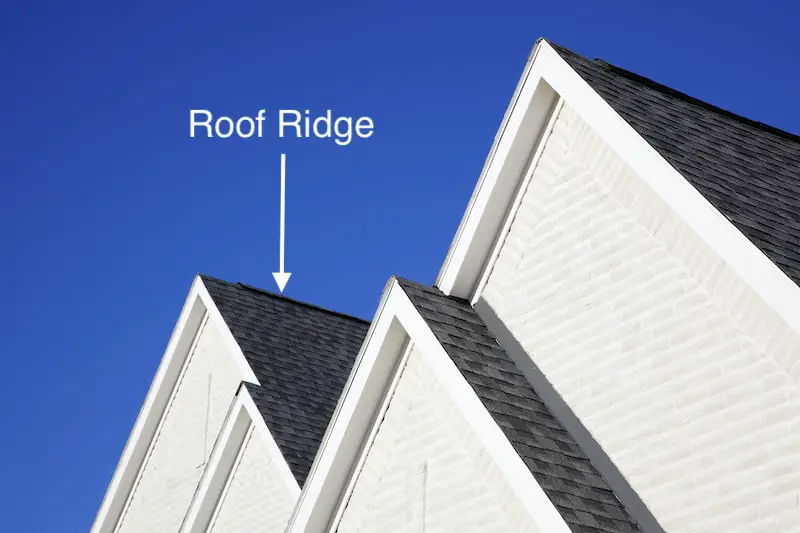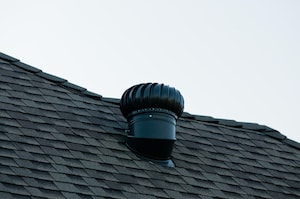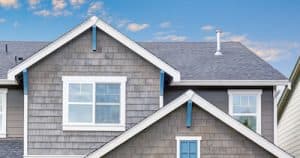As a homeowner, it is important to make sure that your home is properly ventilated. Poor air circulation throughout your home could result in the formation of mold and mildew. One of the most important ways to ventilate your home is by using the proper type of roof vent.
Does my roof need a ridge vent? Yes, If you live in a hot or humid climate a roof ridge vent can lower your cooling bills and lower you attic temperature. A roof ridge vent is the best way to allow damp air to escape your attic, providing proper ventilation. While there are many types of roof vents available, many experts agree that ridge vents are the most efficient and cost-effective ventilation system.
Whether you are preparing to replace your roof, or simply looking to learn more about the systems throughout your home, educating yourself on proper roof ventilation allows you to care for your home more effectively. Keep reading to learn more about why ridge vents are considered the best option for many types of homes.
What is a Roof Ridge Vent?
A ridge vent is a ventilation system that is installed across the ridge of a roof. Covered by shingle caps, this type of vent not only works well but also has an aesthetically pleasing appearance. Some people may refer to this type of roof vent as a continuous vent.

Roof line with ridge vent installed.
Purpose of a Ridge Vent on the Roof
A ridge vent on the roof serves a very important purpose. When a ridge vent is installed, the damp, warm air that accumulates in the attic has a way to escape. This ventilation prevents your home from gathering excessive moisture that can lead to the formation of mold and mildew.
In addition to allowing air to circulate, a ridge vent on your roof prolongs the life of your roof. It also helps to moderate the overall temperature of your home, increasing your energy efficiency. For these, and other, reasons, roof ridge vents are considered an essential part of most modern roof design.
7 Benefits of Roof Ridge Vents
1. Moderate the Temperature of Your Home
2. Prevent Rodents From Entering Attic
3. Ridge Vents Are Aesthetically Pleasing
4. Allows for Natural Air Circulation
5. Ridge Vents Do Not Rely on Other Systems
6. Improves Air Quality Inside Your Home
7. No Risk of Electric or Mechanical Failures
There are many benefits that a roof ridge vent provides. Here are just a few of the many ways it improves the overall condition and value of your home.
1. Moderate the Temperature of Your Home
It is a known fact that hot air rises. Because of this, you will find that the second story of your home is often considerably warmer than the first story, even with the most efficient HVAC system.
Installing a ridge vent will help moderate the temperature of your home by allowing this hot air to escape once it reaches the attic. As a result, your home will remain cooler, reducing the need for endless air conditioner cycles. Roof ridge vents not only make your home more comfortable, but they also reduce your energy bill.
With a growing concern about making homes energy efficient, roof ridge vents are becoming a standard addition to roofs across the country.
2. Prevent Rodents From Entering Attic
There are many types of roof vents, all with different shapes and sizes. Unfortunately, many older styles of roof vents allow rodents to enter your attic. Unless you install traps in your ventilation system, your attic is likely to become the home to baby raccoons, squirrels, mice, or other rodents.
The design of ridge vents, however, prevents rodents of any size from entering your attic without the need for additional traps or blockades. While rodents in your attic may seem harmless at first, they can actually create significant damage. Ridge vents are the best way to achieve the air circulation you need while limiting the risk of further damage.
3. Ridge Vents Are Aesthetically Pleasing
Unlike other types of roof vents, ridge vents are incredibly low-profile. Installed along the ridge of your roof, this type of vent is typically covered by shingle caps. This sleek design is near impossible to notice from ground level.
4. Allows for Natural Air Circulation
Ridge vents allow for the most natural air circulation. When wind blows over your roof, there is a change in air pressure. This pressure change allows help to draw the hot air out of your attic. Fresh, cool air then enters through the underside of the vent, creating a natural airflow.
5. Ridge Vents Do Not Rely on Other Systems
Some types of air ventilation systems rely on other pieces of equipment to work properly. While roof ridge vents can work alongside box vents or soffit vents, they also do not need these other vents to operate.
Ridge vents effectively release moisture from your home, greatly reducing the risk of mold or mildew.
6. Improves Air Quality Inside Your Home
Who wouldn’t want clean, fresh air inside their home? We know that it is important to take steps towards improving the air quality inside our homes! In fact, did you know that indoor air pollution has been ranked as one of the top dangerous environmental factors?
Luckily, ridge vents installed across your roof helps to improve the air quality inside your home. By allowing damp air to escape, and fresh air to enter your home, you can reduce the risk of pollution-related symptoms and ailments.
7. No Risk of Electric or Mechanical Failures
Ridge vents are a non-mechanical ventilation system. Because of this, you will never have to worry about eclectic or mechanical failures or expenses! This helps to offset the higher investment cost required when installing a ridge vent.

Disadvantages of Roof Ridge Vents
As great as roof ridge vents are, there are a few disadvantages to this home ventilation design. Here are a few of the things you need to consider before deciding if a roof ridge vent is the best choice for your home.
Roof Ridge Vents Are Not Ideal for Every Home
Depending on the age and design of your home, roof ridge vents may not be the most effective ventilation system. Most older homes, for example, still need older ventilation systems that work with how the home was designed.
Ridge vents will only work as they should if the rest of the home is designed to promote air circulation. This type of roof vent works best in homes that have been designed to be energy-efficient.
In an older home, you may be able to install roof ridge vents along with a soffit vent system to allow for proper air intake and exchange.
How much do roof ridge vents cost?
Another disadvantage to roof ridge vents is the cost of installation. Especially in an older home that requires additional systems for the ridge vent to work properly, the pricetag for ridge vents can be quite high.
While the cost of installing a roof ridge vent varies depending on the size of your roof and your geographical location, you can expect to spend a minimum of $500 on the ridge vent alone. If you have a complex roof design or unusual roofing material, a roof ridge vent system may cost up to $1,500.
The best way to receive an estimate for installing a roof ridge vent on your home is to work with a professional roofing company in Tulsa.
Do Ridge Vents Leak?
If you live in a region that experiences heavy rains and intense storms, a roof ridge vent may not be the best option for your home. The positioning of your home may also play a role in this decision. If installed properly ridge vents won’t leak due to normal weather conditions. However, the design of ridge events allows for the potential of rain to blow through the vent opening during extreme weather conditions.
In this situation, you would have to inspect your attic for water damage after every storm. This adds an unnecessary task to your to-do list and can become quite frustrating as time passes.
Luckily, there are several other types of roof ventilation that provide a water-tight seal to protect against heavy rain and prevent roof leaks.
Does Not Work for All Roof Styles
Most traditional roofs have a similar design. With a peak at the top that gently slopes down to the sides of the home, a roof ridge is present. However, if your home has a flat roof or a roof that is too steep, a ridge vent will not prove to be the most effective ventilation solution.
Do ridge vents offer enough ventilation?
Most types of roof ventilation systems work best in colder weather climates. If you live in a region that experiences warmer weather, there may be better systems to use to reduce the hot air and moisture in your attic.
However, even in warm weather climates, the presence of a roof ridge vent can aid in proper air circulation and ventilation.
Other Types of Roof Vents
If you determine that a roof ridge vent is not the best design for your home, there are several other alternatives.
What are Box Vents?
Besides ridge vents, box vents are one of the most popular types of non-mechanical roof vents. They work best alongside soffit ventilation, however, some homes rely solely on box vents.
How are Box Vents Installed?
This type of vent is installed over a hole cut in the roof. From the ground, they look like a low-profile metal box sitting on top of the shingles. Unlike a singular ridge vent, you will likely need to install more than one box vent depending on the square footage of your attic.
Similar to ridge vents, box vents rely on the natural wind and air pressure to remove warm air and moisture from the attic. One advantage of box vents is the reduced cost of investment.
What are Soffit Vents?
The soffit is the portion of the roof that overhangs the home. Soffit vents are installed along the soffit between each rafter. With a variety of sizes and designs, soffit vents range from small, round vents to a continuous vent that runs along the length of the home.
This type of ventilation system is often used in conjunction with ridge vents or box vents to allow for optimal air circulation.
What are Turbine Vents?
Turbine vents are perhaps the most abrasive type of vent. Used in many older, more rustic homes, this type of vent features a top that spins on ball bearing. Turbine vents rely on the wind to turn the vent, this draws the wrm air out of the attic. To effectively use turbine vents, you must live in a region where wind speeds are at least 5mph at most times.

Turbine vent helping with air flow on a black roof.
What are Eyebrow Vents?
Eyebrow vents are sometimes called turtle vents. They are curved openings on the slope of the roof, often used in pairs on opposite sides of the slope. Each pair of vents works together to facilitate proper air circulation.
Finding the Right Type of Roof Vent
The best way to determine if your roof needs a ridge vent is to work with a residential roofing company. Whether it is time to replace your roof, or you are just wanting to improve the energy efficiency of your home, a roofing professional will provide you with insight into a ventilation system that is both efficient and cost-effective.
Learn other great roofing tips from experts here.

